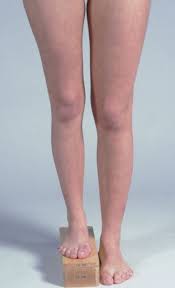Leg Length Discrepancy & Back Pain
Written by Michelle Champlin BSc Pod., M.Ch.S., S.R., Ch., (UK)

Most of us have leg lengths that are slightly different (up to 90% of us) – even our feet aren’t identical. However, this can give us problems in adulthood if the difference is big enough, or even if it’s relatively minor yet we participate in sports/activities that might cause symptoms such as lower back pain.
What is an LLD?
There are two main types of leg length difference/discrepancy (LLD) – functional and anatomical (or ‘true’ LLD). A difference in leg lengths can range from a few milimitres to perhaps 6cm or more. An LLD of 1cm or more can cause you to ‘compensate’ how you stand, walk and run, leading to back, hip, knee and ankle problems.
‘True’ LLD
A true LLD exists when there is an actual difference between leg lengths due to a difference in the length and shape of the bones in the leg. Usually this involves the tibia, fibula and/or femur but sometimes can be more complex and also involve the foot and ankle bones and joints or the pelvis.
Causes of True LLD
A true LLD may exist from birth (congenital), or may be due to damage or infection to the bones or growth plates in childhood. Adults may also experience shortening of a leg following a bone fracture.
‘Functional’ LLD
A functional LLD gives the outer appearance and symptoms of an LLD, but there is no notable asymmetry of the skeletal structure. This apparent difference in measure leg lengths is commonly due to a muscular weakness/imbalance at the hip or foot/ankle joint. An excessively tilted pelvis, over-pronation of the sub-talar joints, genu varum / genu valgum and even injury to various tendons or ligaments in the ankle / leg / hip can cause apparent shortening in one leg by limiting a joint’s movement.
Effects of an LLD
An LLD, whether functional or true, causes your weight and centre of gravity to be shifted more to the short leg side. The pelvis tilts to the short side. Lumbar scoliosis (convex to the short side), knee flexion (increased on the long side) may also be evident. Generally, your body will cope fine with a difference of up to 1cm, but with 2cm or more you will tend to limp.
One of the clinical signs that we frequently (not always) see in patients with an LLD is that their feet do two different things. The foot/ankle joint – or sub-talar joint – of the longer side may over-pronate to a degree (we measure this and will tell you how much). On the shorter side, the foot may supinate. Viewed from the rear of your feet/legs, the long leg ankle joint (over-pronating) will bulge inwards and the short leg ankle (supinating) will bulge outwards. You can see a helpful diagram of how supination / over-pronation can look here.
Symptoms of an LLD
Symptoms of an LLD are varied, depending on how big the difference is, how active you are, underlying cause and so on. Symptoms, and which side of the body they are first experienced, can also depend on whether the LLD is functional or true. General symptoms include lower back pain, knee and/or hip pain, osteoarthritic changes in the knee or hip, ITB syndrome and plantar fasciitis.
First of all, as biomechanics experts, we will want to to carry out a thorough lower limb biomechanical assessment. This will include both static measurements at various marker points on your body, as well as a dynamic gait analysis. We are assessing and analyzing not just your feet, ankles, legs and hips but also the biomechanics of your arms (there may sometimes be a difference in swing for example), head and neck tilt (to the shorter side), spinal deviation, hip tilt / dip (to the shorter side) and so on.
How is an LLD treated?
Correcting an LLD is generally advisable when the patient is experiencing symptoms, such as lower back pain. Treatment options will vary according to the type of LLD (true / functional) and in essence the underlying cause. As experts in lower limb biomechanics and anatomy, Dubai Podiatry Centre seeks to identify the correct cause and recommend the correct treatment plan, either short or longer term.
Treatment may be as straightforward as a custom heel lift or shoe liner worn within existing footwear, footwear modification or perhaps custom orthotic therapy particularly if the LLD is related to a functional anomaly, such as one foot over-pronating. Occasionally, in true LLD cases where the difference is significant, surgery may be advised.
Functional LLD may also involve physiotherapy exercises to improve the pelvic and leg function and flexibility. It is important to note also that correction may be gradual as to immediately ‘correct’ an LLD to ‘match’ the other leg through for an example a heel lift, can be too severe and sudden, causing different pain and symptoms elsewhere.
Michelle Champlin, Chief Podiatrist at Dubai Podiatry Centre cautions though “It is important to note that a certain degree of asymmetry is normal in us all – children included – and can act as a stimulus for children’s normal bone growth and generally speaking need not be corrected. However, if the LLD is significant and other symptoms are present, it is worth ruling out underlying causes including certain illnesses and syndromes.”
If you suspect you have an LLD, have chronic lower back pain that has not been responsive to other treatments, or are a runner with niggling overuse injuries, contact the experts at Dubai Podiatry Centre on 04 3435390 for a thorough assessment and treatment plan.







